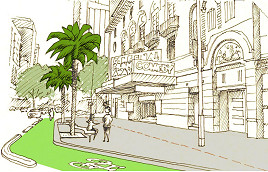Push for a better-designed city welcomes local input
By David Schout
The City of Melbourne’s newly appointed Design Excellence Advisory Committee brings together industry experts, academics and community members to work through design challenges and opportunities facing Melbourne.
CBD News spoke with two locals who form part of the inaugural committee.
It’s been described as a “game changer” for Melbourne.
And while the exact changes won’t be discernible immediately, the new Design Excellence Advisory Committee (DEAC) has a simple mantra: design that benefits the community, not just developers.
“‘Average’ is no longer good enough when it comes to architecture, design and urban amenity in Melbourne,” Deputy Lord Mayor and the council’s planning chair Nicholas Reece said in October.
“‘Average’ does not cut it in recovery mode for the world’s most liveable city … we want to see streets and squares as beautiful as Amsterdam, a skyline that is as classy as Chicago and a design culture that is as hardcore as Copenhagen — all done in a Melbourne way.”
With that in mind, the DEAC will feature a range of “advisors” (such as Eureka Tower architect Karl Fender), “technical experts” (such as Infrastructure Australia CEO Romilly Madew) and, importantly, members of the community.
One of those is Nivedita Ravindran.
A qualified architect and urban designer, Ms Ravindran came to Melbourne three years ago as an international student to complete her masters degree and is now employed within the city.
Her appointment to the DEAC came as a surprise, and she believed her first-hand experience living in the CBD was crucial.
“Being residents of the CBD we get to tell them what works on the ground; it’s the experience of people who actually live here,” she said.
“They’re really receptive of these opinions of the ‘end user’, which I think is really good.”
Originally from Chennai in India, Ms Ravindran said a number of design elements in Melbourne made the city an attractive place to live such as small-scale retail fronts and activations, plus green spaces that, while not as large as those outside the city, were of “high quality and are well maintained”.
However, she had noticed things that could be improved, particularly at the pedestrian level.
This included more opportunities to walk “through” a block rather than around it, less imposing walls of concrete or glass, and generally “activating the ground plane”.
“[It’s about] making use of the under-used spaces like car parks and undercrofts, under bridges — there’s a lot of potential in these spaces, which we have a lot of.”
She also subscribed to the belief that design was about nailing the basics.
“I want to ensure that design excellence is prioritised in every project, not just the ones of state significance. We’ve already spoken about minor changes that could happen at your front porch or on the street level that could have a really big impact for the public.”
Joining Ms Ravindran on the committee is fellow CBD local Daniel Ong.
The only DEAC member without a background in architecture or design, Mr Ong believed he had a unique perspective to offer.
“I represent the kind of citizen who’s working in another field but is nonetheless very engaged and invested in the debate that’s happening in the city, and eager to learn about that,” he told CBD News.
He referred to a quote in the council’s design excellence documents that reads: “Cities with a strong design culture are underpinned by an engaged and demanding public with high expectations for design quality”.
“There’s no mention of a public with design qualifications,” he said.
“Most of us don’t. Design education and engagement is a journey that I’m personally part of and enjoying. My goal would be to encourage people to be similar advocates and take people on a journey with me. If I can learn about design then I think it should be a highly accessible venture that anyone can undertake … it’s about teaching people new words and vocabulary — a new language that they can take into their everyday, and notice details and opportunities they hadn’t noticed before.
And I think that’s exciting. So, hopefully I’m there to represent the every person.”
Born in Singapore and raised in Melbourne, Mr Ong’s professional roles include stints in defence at the federal level and (currently) anti-corruption at the state level.
He has lived in the CBD for six years (from 2017 to now, and during 2002-03), plus various cities across Europe and Asia.
Those experiences, he believed, give him strong experience in what “works” for other global cities.
And for Melbourne, there were certainly areas for improvement.
“What I see is hyper-density in some parts of the city that not only creates an ugly skyline, but very detrimental environmental effects — wind, a lack of sunlight — that eat away at our amenity. I think that’s important to notice and rectify as much as we can.”
Mr Ong, who is a part of CBD-based community group Residents 3000, said the experience of being a parent was also crucial.
He saw a link between good design and establishing a broader demographic.
“It’s about equity and access for me as well and making sure we attract a really broad spread of people to live in the city. Because traditionally, there’s a very young population, with an average age of about 26. And then you’ve got this huge gulf when you start to have kids, and the traditional exodus to the ‘burbs begins. And then you might come back when you’re retired. So, we need that influx of both people internationally, but also that middle-age with kids.”
As for providing input to a committee featuring industry heavyweights, he was simply looking forward to the opportunity.
“I could say daunted, but I’m humbled,” he said.
The committee’s first meeting will take place before the end of 2021 •

Council endorses office tower at Flinders Lane despite querying car park demolition




 Download the Latest Edition
Download the Latest Edition